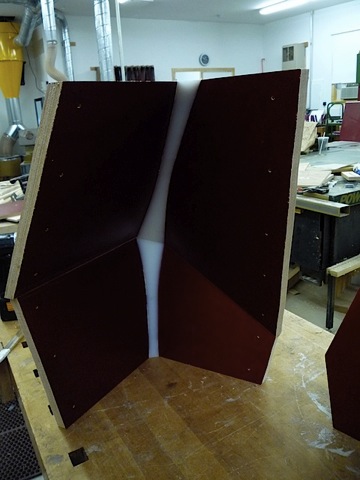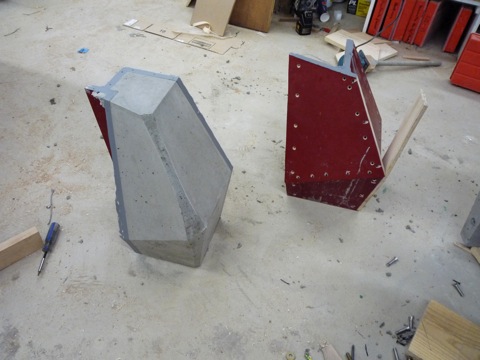Previous: Mold making Materials
Next: Fasteners + Structure
Concrete Mold Making:
Casting a geometric shape begins with having a clear idea of what you want. Make a positive from particle board...just do whatever will help you to proceed with 100% confidence. Trust me there is nothing worse than casting a part like this just to realize that the proportion stinks. I have a collection of poorly proportioned cement moulds.
I have been making concrete casting molds out of a special plywood that is made just for this purpose. The "Red Board" has served me well for multiple castings. That said i am not doing this in great volume but it is still my choice if I think i am going to make a number of castings. If I think the part is more of a one off sort of thing I will use AC plywood. This material is super cheap and ends up giving me the surface finish that I like. I am not going for wood grain in the faces of the concrete. I sand with a random orbit to smooth out the factory makes on the plywood and then I seal it with a blend of polyurethane and mineral spirits. This solution drives into the wood grain and provides good resistance to the water in the concrete. Nothing worse than haveing the mix stick to the cement casting molds so I spray the form with PAM cooking spray to act as a release.
Here are a few pictures of the process
The mold will have to come apart so I concentrate on individual sections to minimize the number of joints that have to be sealed. I use Gorilla glue on the permanent ones.

Another section. There are four pieces to this mold. The removable joints are screwed and caulked with a latex caulk. I find that this combination is the best when it is time to remove the form from the cured concrete. If you use silicone caulk you will damage the form. If you don't seal the joint it will look dry and ragged where the water ran out.

All together and ready for concrete.

The cement mold comes off piece by piece.

I have been making concrete casting molds out of a special plywood that is made just for this purpose. The "Red Board" has served me well for multiple castings. That said i am not doing this in great volume but it is still my choice if I think i am going to make a number of castings. If I think the part is more of a one off sort of thing I will use AC plywood. This material is super cheap and ends up giving me the surface finish that I like. I am not going for wood grain in the faces of the concrete. I sand with a random orbit to smooth out the factory makes on the plywood and then I seal it with a blend of polyurethane and mineral spirits. This solution drives into the wood grain and provides good resistance to the water in the concrete. Nothing worse than haveing the mix stick to the cement casting molds so I spray the form with PAM cooking spray to act as a release.
Here are a few pictures of the process
The mold will have to come apart so I concentrate on individual sections to minimize the number of joints that have to be sealed. I use Gorilla glue on the permanent ones.

Another section. There are four pieces to this mold. The removable joints are screwed and caulked with a latex caulk. I find that this combination is the best when it is time to remove the form from the cured concrete. If you use silicone caulk you will damage the form. If you don't seal the joint it will look dry and ragged where the water ran out.

All together and ready for concrete.

The cement mold comes off piece by piece.

Previous: Mold making Materials
Next: Fasteners + Structure